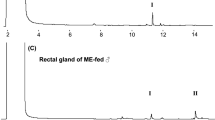Abstract
Pederin, a hemolymph toxin found in the rove beetle genusPaederus, is quantified in individual specimens ofP. fuscipes andP. riparius. Whereas males always contain only small quantities of the toxin (0.1–1.5 µg), females are not so restricted (0.2–20.5 µg) and in most cases possess roughly 10-fold that in males. There are, however, females containing as little pederin as the males, and so two clearly separate groups of females can be discerned. These two groups hint at two types of females defined by the eggs they lay. About 85% of the females, i.e., those containing much of the substance, transfer pederin into every egg and thus are denoted (+)-females. The remaining 15%, the (−)-females, contain at best small amounts of the toxin, which is transferred in minute quantities into the first eggs while the subsequent ones lack pederin. With respect to the pederin content of their eggs, there is no overlap between these two types of females. If fed with pederin, (−)-females can transfer it into the eggs like (+)-females. After hatching the larvae store pederin when present. Larvae are not able to biosynthesize the toxin on their own, but storage of that received in the egg is very efficient, and the difference between larvae with and without pederin is preserved until imaginal eclosion. In (+)-females, pederin increases, probably reflecting a biosynthetic capacity, but in males and presumptive (−)-females the amount of pederin never exceeds the quantity transferred by parental (+)-females. Consequently, males and (−)-females probably are unable to biosynthesize pederin. This polymorphism of females may have a genetic basis. Individuals of all stages nevertheless sequester pederin if it is supplied with the diet.
Similar content being viewed by others
References
Blum, M.S. 1981. Chemical Defenses of Arthropods. Academic Press, New York.
Cardani, C., Ghiringhelli, D., Mondelli, R., Pavan, M., andQuilico, A. 1965a. Propriétés biologiques et composition chimique de la pédérine.Ann. Soc. Entomol. Fr. 1:813–816.
Cardani, C., Ghiringhelli, D., Mondelli, R., andQuilico, A. 1965b. The structure of pederin.Tetrahedron Lett. 29:2537–2545.
Cardani, C., Ghiringhelli, D., Mondelli, R., andQuilico, A. 1966. Struttura della pederina.Gazz. Chim. Ital. 96:3–38.
Cardani, C., Ghiringhelli, D., Quilico, A., andSelva, A. 1967. The structure of pederone, a novel substance fromPaederus (Coleoptera Staphylinidae).Tetrahedron Lett. 41:4023–4025.
Cardani, C., Fuganti, C., Ghiringhelli, D., Grasselli, P., Pavan, M., andValcurone, M.D. 1973. The biosynthesis of pederin.Tetrahedron Lett. 30:2815–2818.
Carrel, J.E., McCairel, M.H., Slagle, A.J., Doom, J.P., Brill, J., andMcCormick, J.P. 1993. Cantharidin production in a blister beetle.Experientia 49:171–174.
Dettner, K. 1993. Defensive secretions and exocrine glands in free-living staphylinid beetles—their bearing on phylogeny (Coleoptera: Staphylinidae).Biochem. Syst. Ecol. 21:143–162.
Dirzo, R., andHarper, J.L. 1982. Experimental studies on slug-plant interactions. IV. The performance of cyanogenic and acyanogenic morphs ofTrifolium repens in the field.J. Ecol. 70:119–138.
Frank, J.H., andKanamitsu, K. 1987.Paederus, sensu lato (Coleoptera: Staphylinidae): Natural history and medical importance.J. Med. Entomol. 24:155–191.
Holz, C., Streil, G., Dettner, K., Dutemeyer, J., andBoland, W. 1994. Intersexual transfer of a toxic terpenoid during copulation and its paternal allocation to developmental stages: Quantification of cantharidin in cantharidin-producing oedemerids (Coleoptera: Oedemeridae) and canthariphilous pyrochroids (Coleoptera: Pyrochroidae).Z. Naturforsch. 49c:856–864.
Horion, A. 1965. Staphylinidae Teil 2: Paederinae, pp. 1–84,in Faunistik der mitteleuropäischen Käfer, Vol. 10. Klostermann. Frankfurt a. M.
Ito, Y. 1934. Zur Kenntnis desPaederus-Giftes und der Dermatitis linearis. (IV. Mitteilung).Fukuoka Acta Med. 27:58–59.
Jones, D.A. 1972. Cyanogenic glycosides and their function, pp. 103–124,in J.B. Harborne (ed.). Phytochemical Ecology. Annual Proceedings of the Phytochemical Society. No. 8. Academic Press, London.
Jork, H., Funk, W., Fischer, W., andWimmer, H. 1989. Physikalische und chemische Nachweismethoden: Grundlagen, Reagenzien I, Vol. la of Dünnschicht-Chromatographic, Reagenzien und Nachweismethoden. VCH Verlagsgesellschaft, Weinheim.
Kurosa, K. 1958. Studies on the life history ofPaederus fuscipes Curtis (Staphylinidae) (Studies on poisonous beetle, III).Jpn. J. Sanit. Zool. 9:245–276.
Matsumoto, T., Yanagiya, M., Maeno, S., andYasuda, S. 1968. A revised structure of pederin.Tetrahedron Lett. 60:6297–6300.
Netolitzky, F. 1919. Eine neue Gruppe blasenziehender Käfer aus Mitteleuropa (Paederus, Staphylinidae).Z. Angew. Entomol. 5:252–257.
Pavan, M. 1963. Ricerche biologiche e mediche su pederina e su estratti purificati diPaederus fuscipes Curt. (Coleoptera Staphylinidae). Mario Ponzio, Pavia.
Pavan, M. 1975. Sunto delle attuali conoscenze sulla pederina. Pubblicazioni dell'Istituto di Entomologia Agrania dell' Università di Pavia. pp. 1–35.
Pavan, M., andBo, G. 1953. Pederin, toxic principle obtained in the crystalline state from the beetlePaederus fuscipes Curt.Physiol. Comp. Oecol. 3:307–312.
Pavan, M., andValcurone Dazzini, M. 1971. Toxicology and pharmacology—Arthropoda, pp. 365–409,in M. Florkin and B.T. Scheer (eds.). Chemical Zoology, Vol. IV. Arthropoda Part B. Academic Press, New York.
Pawlowsky, E.N., andStein, A.K. 1927. Experimentelle Untersuchung über die Giftwirkung vonPaederus fuscipes Curt. (Coleoptera, Staphylinidae) auf den Menschen.Arch. Schiffs. Trop. Hyg. 31:271–282.
Quilico, A., Cardani, C., Ghiringhelli, D., andPavan, M. 1961. Pederina e pseudopederina.Chim. Ind. 43:1434–1436.
Sachs, L. 1984. Angewandte Statistik, 6th ed. Springer-Verlag, Berlin.
Sierra, J.R., Woggon, W.-D., andSchmid, H. 1976. Transfer of cantharidin during copulation from the adult male to the femaleLytta vesicatoria (“Spanish flies”).Experientia 32:142–144.
Théodorides, J. 1950. Considérations sur lesPaederus vésicants (Coleoptera: Staphylinidae) et essais de vésication avec des espèces de France.Bull. Soc. Pathol. Exot. 43:100–113.
Vorderman, A.G. 1901. Huiduitslag veroorzaakt doorPaederus peregrinus, Fabr.Geneesk. Tijdschr. Ned. Indie 41:282–284.
Author information
Authors and Affiliations
Rights and permissions
About this article
Cite this article
Kellner, R.L.L., Dettner, K. Allocation of pederin during lifetime ofPaederus rove beetles (Coleoptera: Staphylinidae): Evidence for polymorphism of hemolymph toxin. J Chem Ecol 21, 1719–1733 (1995). https://doi.org/10.1007/BF02033672
Received:
Accepted:
Issue Date:
DOI: https://doi.org/10.1007/BF02033672




